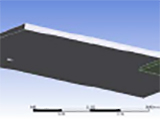Authored By:
Vishnu V. B. Reddy, I. Charles Ume, Aaron M. Mebane
Georgia Institute of Technology
GA, USA
Kola Akinade, Amiya R. Chaudhuri, Bryan Rogers, Cherif Guirguis, Kathy Derksen, Parimal Patel MGMT-Quality, Cisco Systems, Inc.
GA, USA
Summary
Flip chip packaging has a higher performance, and I/O density when compared with wire bonded packaging. However, wire bonding is extensively used in the electronic packaging industry. One of the difficulties with flip chip technology is testing its reliability. Advancements in Scanning Acoustic Microscopy (SAM) can provide insight into 1st level joint interconnects. However, these traditional solder joint inspection methods have been very unsatisfactory in assessing 2nd level interconnects because of the location and physical configuration of these solder joints. Non-destructive methods like SAM and X-Ray have their own limitations in assessment of 2nd level interconnects.
The Laser Ultrasonic Inspection Technique uses laser pulses to generate bulk ultrasonic waves in the package, and the reflected waves from the 2nd level interconnect can give us information about the quality of the joint. A fiber-coupled laser interferometer is used to measure the transient out of plane displacements on the surface of the package. This is a direct measure of the reflected ultrasonic wave strength. Laser power can be adjusted depending on the size of the package to generate bulk waves of sufficient strength to reach the interconnections. In this project, Flip Chip Ball Grid Array (FCBGA) packages (foot print size 52.5mm x 52.5mm) from Cisco Systems were subjected to mechanical shock tests and analyzed using a Laser Ultrasonic Inspection (LUI) system.
The results are validated using cross sectioning method. The samples are also tested using X-Ray and C-SAM, and the results are compared with those of the LUI system. The LUI system test results have demonstrated that the LUI method holds a great promise for assessing the presence of defects in 2nd level interconnects.
Conclusions
Laser Ultrasonic inspection (LUI) is a unique and promising non-destructive inspection technique for assessing 2nd level interconnection quality, and determining the presence of BGA solder ball defects in FCBGA packages. Reasonable efforts have been made to detect 2nd level interconnect defects using acoustic microscopy, and 2D X-ray. It is concluded that only LUI can detect IMC and pad cratering defects. LUI results are validated with FEM and cross-sectional SEM images. The LUI system not only captures the general trend of 2nd level interconnection quality, but also estimates the defect severity by using MCC values. It is found that drop testing can induce pad cratering and IMC defects in test samples. Although the LUI technique could not distinguish the type of the defect, LUI could successfully detect minor cracks in 2nd level interconnections. Further efforts are in place to improve the sensitivity and resolution of the system by using high laser power to detect micro cracks in packages.
Initially Published in the SMTA Proceedings
|

